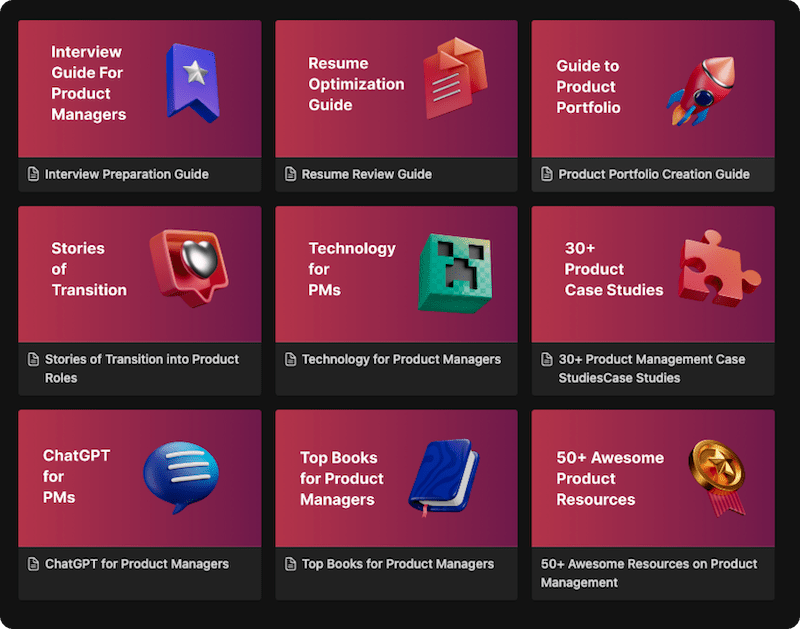Product managers need a unique blend of technical expertise, market insight, and strategic vision. Among the myriad skills valued in product management interviews, the ability to make well-reasoned estimates stands out.
This article explores why mastering guesstimates is crucial for product managers and provides a comprehensive guide to excelling in this area.
Introduction to Guesstimates
Do you also get asked questions such as:
“How many golf balls can fill an Olympic Swimming Pool?”
“What is the estimated number of ATMs in India?”
“Estimate the daily revenue of a McDonald’s store”
If you get puzzled and afraid after hearing such questions, we have got your back.
These questions are known as Guesstimates.
Guesstimates involve making reasoned calculations or estimates when exact data is unavailable. It’s a combination of “guess” and “estimates.” They are not about wild guesses. Instead, they involve applying logical reasoning to arrive at a ballpark figure.
In product management interviews, guesstimates showcase your analytical thinking, comfort with numbers, and ability to make informed decisions under uncertainty.
Guesstimates is one of the various kinds of questions asked in product management interviews and in this blog, we will discuss how to approach them.
The Role of Guesstimates in Product Management
Understanding Market Sizing Through Guesstimates
In new and growing industries, it’s tough to find hard facts.
Hence, we need to make educated guesses, or “guesstimates,” to figure out how big the market might be. We look at things like how many people might be interested, what the competition is doing, and any other clues we can find.
These guesses help us decide if and how we should enter a new market, giving us a basic idea of what to expect.
Feature Prioritization with Guesstimates
Deciding which features to add to a product is tricky.
We have to think about what users want, how much time and money we have, and what’s best for the business. Guesstimates help product managers figure out which features might make the biggest impact.
This way, we can plan better and make sure we’re working on the right things, keeping both users and the business happy.
Strategic Resource Allocation Informed by Guesstimates
When we decide how to spend our budget or assign our team members, we rely on guesstimates. Product managers make educated guesses about how much things will cost and how much work they’ll need.
Even if these guesses aren’t perfect, they help us make smart choices about where to use our resources best.
Risk Mitigation Through Proactive Guesstimates
Guessing ahead of time can also help us dodge potential planning problems. By thinking about what could go wrong and making plans for those cases, we can avoid a lot of surprises.
This helps keep projects on track and makes sure we deliver what we promised.
Forecasting Product Performance with Guesstimates
Trying to predict a product’s success is like looking into a magic ball 🔮.
Guesstimates help us imagine how well a product might do by using what we know about the past and what’s happening right now. This helps us set goals, adjust our plans based on how things are going, and develop our strategic thinking.
Types of Guesstimate Questions
Quantitative Estimations or Market Sizing
Questions involve estimating numerical values, quantities, or the size of markets or segments.
- Number of iPhone users in India at present
- How many teacups were consumed in Bangalore last week?
Spatial and Volume Estimations
Spatial estimates involve calculating distances, areas, or volumes, which are particularly relevant in product design and logistics.
- How much paint would you need to paint the Eiffel Tower?
- How many tennis balls can fit in an Olympic-sized swimming pool?
Product/Revenue Estimates:
Some guesstimate questions require a combination of logic and problem-solving skills.
Estimating the revenue or sales figures of a particular product or service is fundamental for assessing its success and planning for growth.
- How much does a Domino’s outlet earn in a day?
- Estimate the revenue of the Hindu Newspaper
Framework for Solving Guesstimate Questions
Ask for Clarification and Clear Out the Scope:
– It is good to ensure you understand what the problem is asking for before you start.
– Seek clarification of any part of the question that you do not understand.
– Being on the same wavelength as the interviewer avoids misunderstandings.
– Remember the aim is to get on the same page as the interviewer and not hunt for answers.
– This enables you to concentrate on the relevant areas and prevents unnecessary work.
Brainstorm Loudly:
– Share your thought process as you tackle the problem.
– Voicing your thoughts keeps you on track and allows for feedback.
– It’s fine to pivot your strategy if you discover a more viable direction.
– This keeps the dialogue lively and demonstrates your thought process to the interviewer.
Create an Equation:
– Decompose the problem into segments to discern knowns from unknowns.
– Craft an equation or formula to outline the relationships between these elements.
– This provides a straightforward structure to guide your analysis.
– Adjusting variables becomes simpler as you gather more data or progress.
Keep Your Numbers Easy:
– Simplify numbers to facilitate easier calculations.
– Avoid using intricate numbers or decimals.
– This accelerates computations and minimizes the likelihood of mistakes.
– Working with rounded figures and estimates is generally more manageable.
Map Out Your Calculations:
– Strategize your approach to solving the problem.
– Segment the problem into smaller, more manageable tasks.
– This ensures you remain methodical and focused.
– Address each component of the problem in a systematic manner.
Round Numbers and Calculate:
– Apply basic mathematical operations such as addition, subtraction, multiplication, and division.
– Round numbers for ease of calculation.
– This approach streamlines the problem and quickens your pace.
– Aim for a ballpark figure rather than pinpoint accuracy.
Answer Almost Never Matters:
– Bear in mind that the interviewer’s interest lies in your analytical process, not solely the final answer.
– Concentrate on elucidating your problem-solving approach and the rationale behind your choices.
– Avoid obsessing over the precision of your result.
– Displaying your problem-solving abilities and analytical thinking is paramount.
Do a Summary and Sanity Check in the End:
– Recapitulate your method, assumptions, and logic.
– Reassess your solution to ensure its sensibility.
– Compare your answer to real-world data or what seems likely to make sure your answer is reasonable.
– It’s worth looking out for the possibility of an answer.
– This final step helps you catch any mistakes and ensures your answer is plausible.
So to revise:
- Understand the question, scope, and limitations by asking the right clarification questions.
- Brainstorm loudly, and create an equation.
- Keep your numbers easy.
- Calculate, and do a sanity check.
Remember that final answer isn’t the most important thing, its your process and thinking muscle that is being judged.
Example –1
Calculate the number of queries answered by Google per second
- Clarification and Scope:
We have clarified that we are estimating the total number of queries answered by Google for every location present on earth, without geographical constraints.
- Brainstorming and Structure:
We’ve chosen a top-down approach, estimating the number of Google Users and then translating this into the number of queries asked per second.
We can segment them according to their frequency of usage.
We can assume 3 types of searchers: Aggressive, Active and Passive
- Creating an Equation:
The total number of Google Searches on Earth is derived from the total of Google Searches by Aggressive, Active and Passive searchers. The equation can be outlined as follows:
Total Google Search Queries = Google Searches by Aggressive Users + Google Searches by Active Users + Google Searches by Passive Users
- Map out Calculations and Keep Your Numbers Easy:
Earth’s population is around 8 billion people.
Since Google isn’t available in China, we subtract about 1.5 billion from that, leaving us with roughly 6.5 billion potential users.
About 75% of the world has internet access, meaning around 4.875 billion people can go online.
Google dominates the search engine market with about 80% share.
So, we estimate around 3.9 billion people worldwide use Google for their searches.
Further we can segment these users according to their frequency of usage
- Aggressive – Assuming 30% of the users are active users and they make 5 Searches daily on an average
- Active – Assuming 40% of the users are active users and they make 3 Searches daily on an average
- Passive – Assuming 30% of the users are active users and they make 1 Search daily on an average
- Round Numbers and Calculate:
Number of Aggressive users – 1.17 billion
Number of Active users – 1.56 billion
Number of Passive users – 1.17 billion
Searches made by Aggressive users daily – 1.17 x 5 = 5.85 billion
Searches made by Active users daily – 1.56 x 3 = 4.68 billion
Searches made by Passive users daily – 1.17 x 1 = 1.17 billion
Total Searches in a day = 5.85 billion + 4.68 billion + 1.17 billion = 11.7 billion
Number of Seconds in a day = 24 x 60 x 60 = 86400
Total Searches per Second = 11.7 billion / 86400 = 135417
Example -2
Estimate the Number of ATMs in India
- Clarification and Scope:
We have clarified that we are estimating the total number of active ATMs for all banks across India, without geographical constraints.
- Brainstorming and Structure:
We’ve chosen a top-down approach, estimating the number of ATM users and then translating this into the number of ATMs needed.
This method allows us to systematically address the problem by focusing on key variables: population, urban-rural split, household size, and assumptions on ATM usage.
- Creating an Equation:
The total number of ATMs in India is derived from the ATM users in both urban and rural areas. The equation can be outlined as follows:
Total ATMs = ATMs in Urban India + ATMs in Rural India
- Map out Calculations and Keep Your Numbers Easy:
Total Population: 1.5 billion
Urban Population: 30% (450 million)
Rural Population: 70% (1.05 billion)
With an average household size of 4:
- Round Numbers and Calculate:
Urban Families: 112.5 million
Rural Families: 262.5 million
Assuming 80% of urban households and 30% of rural households have ATM users:
Urban Households with ATM Users: 90 million
Rural Households with ATM Users: 78.75 million
Adjusting for Multiple Users per Household:
10% of households have 2 users: 78.75 million * 10% * 2 = 15.75 million
90% have 1 user: 78.75 million * 90% = 70.875 million
Total Rural ATM Users = 15.75 million + 70.875 million = 86.625 million
30% of households have 2 users: 90 million * 30% * 2 = 54 million
70% have 1 user: 90 million * 70% = 63 million
Total Urban ATM Users = 54 million + 63 million = 117 million
Assuming one ATM/5000 users in Rural India, and one ATM/500 users in Urban India
Calculating ATMs Needed:
Rural ATMs = 86.625 million / 5000 = 17,325 ATMs
Urban ATMs = 117 million / 500 = 234,000 ATMs
Total ATMs in India:
Total ATMs = Rural ATMs + Urban ATMs = 17,325 + 234,000 = 251,325 ATMs
According to Statista the actual number of estimated ATM’s in India is ~266000 which is ~95% close to our estimate
Example – 3
Estimate the Daily revenue of a McDonald’s store in India
- Clarification and Scope:
Where is the store located?
- Delhi, CP
A day means weekday, weekend or on average?
- Average Day
Post Covid or Pre Covid Scenario?
- Pre Covid
Dine In + Takeaways or Deliveries also included?
- Dine In + Takeaways only
- Brainstorming and Structure:
We will adopt a bottom-up approach, dividing the day into different slots and estimating demand based on the day of the week and the time.
This method will allow us to calculate the average revenue for both weekdays and weekends, thereby helping us determine the average revenue of any given day.
- Creating an Equation:
No.of hours the store is open x No.of customer groups per hour x Average bill per customer
- Map out Calculations and Keep Your Numbers Easy:
We have segmented our weekdays and weekends into Peak Hours and Non-Peak Hours, based on which we will further calculate the number of customer groups visiting during peak and non-peak hours.
| Weekdays | Peak Hours | 2PM – 4PM/8PM – 10PM | 4 hours |
| Non Peak Hours | 10AM – 2PM/4PM – 8PM | 8 hours | |
| Weekend | Peak Hours | 1PM – 4PM/7PM – 10PM | 6 hours |
| Non Peak Hours | 10AM – 1PM/4PM – 7PM | 6 hours |
- Round Numbers and Calculate:
Assuming that on an average a store has a capacity to serve 150 customers at a given time and turn around time is 60 minutes.
- During weekday peak hours, there is an occupancy rate of 80%, which equates to 120 customers.
- During weekday off-peak hours, the occupancy rate drops to 60%, corresponding to 90 customers.
- Over the weekend, peak hours see a full occupancy rate of 100%, or 150 customers.
- During weekend off-peak hours, the occupancy rate is at 80%, equivalent to 120 customers.
| Day | Peak/Non Peak | Time Slots | Hours | Occupancy % | Customers served per hour | Total Customers Served |
| Weekdays | Peak Hours | 2PM – 4PM8PM – 10PM | 4 hours | 80% | 120 | 120 x 4 = 480 |
| Non Peak Hours | 10AM – 2PM4PM – 8PM | 8 hours | 60% | 90 | 90 x 8 = 720 | |
| Weekend | Peak Hours | 1PM – 4PM7PM – 10PM | 6 hours | 100% | 150 | 150 x 6 = 900 |
| Non Peak Hours | 10AM – 1PM4PM – 7PM | 6 hours | 80% | 120 | 120 x 6 = 720 |
Average order value per customer
- Weekday Peak Hours – Rs 150
- Weekday Non Peak Hours – Rs 100
- Weekend Peak Hours – Rs 180
- Weekend Non Peak Hours – Rs 120
| Day | Peak/Non Peak | Time Slots | Hours | Occupancy % | Customers served per hour | Total Customers Served | Average order value per customer | Total Revenue |
| Weekdays | Peak Hours | 2PM – 4PM8PM – 10PM | 4 hours | 80% | 120 | 120 x 4 = 480 | 150 | 480 x 150 = 72000 |
| Non Peak Hours | 10AM – 2PM4PM – 8PM | 8 hours | 60% | 90 | 90 x 8 = 720 | 100 | 720 x 100 = 72000 | |
| Weekend | Peak Hours | 1PM – 4PM7PM – 10PM | 6 hours | 100% | 150 | 150 x 6 = 900 | 180 | 900 x 180 = 108000 |
| Non Peak Hours | 10AM – 1PM4PM – 7PM | 6 hours | 80% | 120 | 120 x 6 = 720 | 120 | 720 x 120 = 86400 |
Average Revenue = [(Weekday Revenue x 5) +(Weekend Revenue x 2)] / 7
Average Revenue = [(144000 x 5) + (194400 x 2)]/7
Average Revenue = 158,400
Must do Guesstimates for aspiring Product Managers and Management Consultants
- How many orders does Zomato and Swiggy do in a day?
- How many flights take off from New Delhi every hour?
- How many photos are uploaded on instagram every day?
- Calculate the number of queries answered by Google per second.
- Estimate the number of Uber rides in India
Conclusion
Guessing well is a super important skill for anyone wanting to be a great product manager. It is also important for those who already are. This skill helps a lot when it comes to figuring out how big the market is. It also helps in deciding which features are the most important. It helps in putting resources in the right places, avoiding risks, and guessing how well a product will do.
Guessing well is especially useful for product managers. It helps when they’re working in new markets or nascent industries. It helps them make smart choices even when there’s not a lot of solid information available. This is very important in fast-changing fields like technology and innovation. It’s hard to predict what will happen next.
Product managers can turn guessing into a key part of their strategy by thinking carefully and using their analytical skills. This helps them create plans for products that focus on what users need and want. It also helps them meet the goals of the business and keep up with what the market wants. Product managers can make sure their plans are based on information by using good guesses. They can also change plans when unexpected things happen or new opportunities arise.
Looking to get into to high-growth product role? Check out our flagship product management boot camp.

 WATCH HELLOPM COHORT IN ACTION
WATCH HELLOPM COHORT IN ACTION


